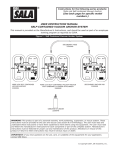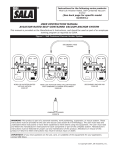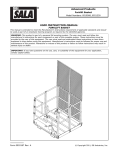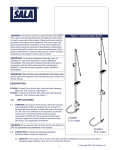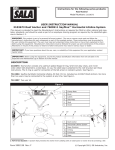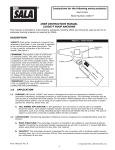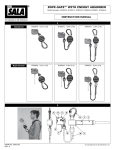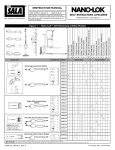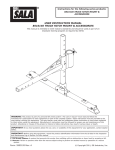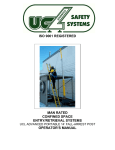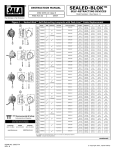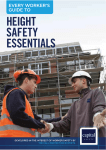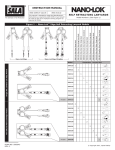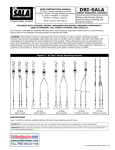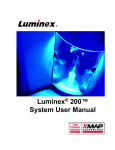Download Mobi-Lok™ SCVA Instruction Manual
Transcript
Instructions for the following series products: Mobi-Lok Aviation Rated, Self-Contained Vacuum Anchor (See back page for specific model numbers.) USER INSTRUCTION MANUAL AVIATION RATED SELF-CONTAINED VACUUM ANCHOR SYSTEM This manual is provided as the Manufacturer’s Instructions, and should be used as part of an employee training program as required by OSHA. Figure 1 - Self-Contained Vacuum Anchor System SECONDARY HOSE 2200130 WARNING WARNING INSPECTION Before each use, inspect vacuum anchor for damaged, worn, loose, or missing components. Inspect vacuum pads and hoses for cuts or other damage. Periodically, according to conditions of use, a competent person other than the user must inspect the vacuum anchor. See user manual for inspection and factory service schedule. Do not use if inspection reveals an unsafe condition. ING Do not use pad unless attached to and vacuum SEC ANC WARNING Manufacturer's instructions must be read and understood prior to use. Instructions supplied with this product at time of shipment must be followed. This anchorage device must only be installed and used under the super- vision of a qualified person as part of a complete personal fall arrest system, which maintains a safety factor of at least two. Do not use vacuum anchor where pad will not seal properly or leakage is apparent. Do not attach vacuum anchor to structurally inappropriate materials or surfaces. Refer to user manual for temperature operation limits. Alteration or misuse of this product, or failure to follow instructions may result in serious injury or death. ry anchor nchor pad is ng surface indicates green. ARY PAD SPECIFICATIONS This apparatus is intrinsically safe and is suitable for use in Class I, Division 1, Group D, T4 @ Ta = 115°F (46°C) max hazardous locations Materials of construction: Natural Rubber/Polybutadiene Aluminum Capacity: One user, 310 lbs. (141 Kg) Anchor strength: 3,375 lbs. minumum (15 kN) Maximum Surface Temperature: 140°F (60°C) Patent No: US 6,547,033 GB 2,313,396 AU 712,249 OTHER PATENTS PENDING RELEASE MOBI-L ING Do not use pad unless attached to and vacuum SEC ANC Manufacturer's instructions must be read and understood prior to use. Instructions supplied with this product at time of shipment must be followed. This anchorage device must only be installed and used under the super- vision of a qualified person as part of a complete personal fall arrest system, which maintains a safety factor of at least two. Do not use vacuum anchor where pad will not seal properly or leakage is apparent. Do not attach vacuum anchor to structurally inappropriate materials or surfaces. Refer to user manual for temperature operation limits. Alteration or misuse of this product, or failure to follow instructions may result in serious injury or death. ry anchor nchor pad is ng surface indicates green. ARY PAD WARNING This product is i-Safe enabled and contains an electronic tag that can be read by compatible readers - providing inspection logs, inventory management and other safety information. INITIAL DATE INITIAL MOBI-LOK AVIATION RATED VACUUM ANCHOR 2200107 WARNING Manufacturer's instructions must be read and understood prior to use. Instructions supplied with this product at time of shipment must be followed. This anchorage device must only be installed and used under the super- vision of a qualified person as part of a complete personal fall arrest system, which maintains a safety factor of at least two. Do not use vacuum anchor where pad will not seal properly or leakage is apparent. Do not attach vacuum anchor to structurally inappropriate materials or surfaces. Refer to user manual for temperature operation limits. Alteration or misuse of this product, or failure to follow instructions may result in serious injury or death. chor ir to ET Structure to which the vacuum anchor is attached must be capable of supporting the loads imposed by the vacuum anchor due to fall arrest, see user manual. Locate vacuum anchor and rig fall arrest system to minimize free fall and swing fall hazards. Ensure sufficient clearance exists in the work area to avoid striking an object or lower level should a fall occur. Clean area where pad is to be attached of loose debris and excess moisture before applying vacuum. A full body harness is recommended for use with this device. Avoid lanyard contact with sharp edges. If alarm sounds, move to a safe area and disconnect from vacuum anchor until normal operation resumes. For use by trained persons only. See user manual for more details. Do not remove this label. ATTACH R A CAPITAL SAFETY BRAND www.capitalsafety.com (800)328-6146 Self Contained Vacuum Anchor OK X RELEASE TM This product is i-Safe enabled and contains an electronic tag that can be read by compatible readers - providing inspection logs, inventory management and other safety information. Self Contained Vacuum Anchor SPECIFICATIONS This device is not user repairable. To reduce the risk of ignition of a flammable or explosive atmosphere, batteries must be changed only in a location known to be nonhazardous. For replacement batteries, use only Capital Safety part number 9501987. To reduce the risk of explosion, do not mix old batteries with used batteries. See manufacturer's instructions (5902400) for more information. 3,000 psi (20 MPa) TM ct is i-Safe enabled and contains an c tag that can be read by compatible - providing inspection logs, inventory ement and other safety information. INSPECTION LOG DATE VACUUM ATTACH WARNING TM WARNING n PRIMARY NCHOR PAD RELEASE MOBI-L This apparatus is intrinsically safe and is suitable for use in Class I, Division 1, Group D, T4 @ Ta = 115°F (46°C) max hazardous locations Materials of construction: Natural Rubber/Polybutadiene Aluminum Capacity: One user, 310 lbs. (141 Kg) Anchor strength: 3,375 lbs. minumum (15 kN) Maximum Surface Temperature: 140°F (60°C) Patent No: US 6,547,033 GB 2,313,396 AU 712,249 OTHER PATENTS PENDING This device is not user repairable. To reduce the risk of ignition of a flammable or explosive atmosphere, batteries must be changed only in a location known to be nonhazardous. For replacement batteries, use only Capital Safety part number 9501987. To reduce the risk of explosion, do not mix old batteries with used batteries. See manufacturer's instructions (5902400) for more information. This anchor pad must be used in conju with a DBI-SALA SCVA primary anchor Do not disconnect vacuum hose while pad is in use. Do not connect compr the vacuum inlet on this anchor pad. X A CAPITAL SAFETY BRAND www.capitalsafety.com (800)328-6146 80-150 PSI SPECIFICATIONS OK WARNING Structure to which the vacuum anchor is attached must be capable of supporting the loads imposed by the vacuum anchor due to fall arrest, see user manual. Locate vacuum anchor and rig fall arrest system to minimize free fall and swing fall hazards. Ensure sufficient clearance exists in the work area to avoid striking an object or lower level should a fall occur. Clean area where pad is to be attached of loose debris and excess moisture before applying vacuum. A full body harness is recommended for use with this device. Avoid lanyard contact with sharp edges. If alarm sounds, move to a safe area and disconnect from vacuum anchor until normal operation resumes. For use by trained persons only. See user manual for more details. Do not remove this label. R DEPRESS BUTTON TO BYPASS ALARM X A CAPITAL SAFETY BRAND www.capitalsafety.com (800)328-6146 Self Contained Vacuum Anchor Before each use, inspect vacuum anchor for damaged, worn, loose, or missing components. Inspect vacuum pads and hoses for cuts or other damage. Periodically, according to conditions of use, a competent person other than the user must inspect the vacuum anchor. See user manual for inspection and factory service schedule. Do not use if inspection reveals an unsafe condition. ATTACH R DEPRESS BUTTON TO BYPASS ALARM 80-150 PSI WARNING INSPECTION Structure to which the vacuum anchor is attached must be capable of supporting the loads imposed by the vacuum anchor due to fall arrest, see user manual. Locate vacuum anchor and rig fall arrest system to minimize free fall and swing fall hazards. Ensure sufficient clearance exists in the work area to avoid striking an object or lower level should a fall occur. Clean area where pad is to be attached of loose debris and excess moisture before applying vacuum. A full body harness is recommended for use with this device. Avoid lanyard contact with sharp edges. If alarm sounds, move to a safe area and disconnect from vacuum anchor until normal operation resumes. For use by trained persons only. See user manual for more details. Do not remove this label. LOG DATE INITIAL MOBI-LOK AVIATION RATED VACUUM ANCHOR WITH ONBOARD CYLINDER ATTACHMENT 2200108 This apparatus is intrinsically safe and is suitable for use in Class I, Division 1, Group D, T4 @ Ta = 115°F (46°C) max hazardous locations Materials of construction: Natural Rubber/Polybutadiene Aluminum Capacity: One user, 310 lbs. (141 Kg) Anchor strength: 3,375 lbs. minumum (15 kN) Maximum Surface Temperature: 140°F (60°C) Patent No: US 6,547,033 GB 2,313,396 AU 712,249 OTHER PATENTS PENDING INSPECTION Before each use, inspect vacuum anchor for damaged, worn, loose, or missing components. Inspect vacuum pads and hoses for cuts or other damage. Periodically, according to conditions of use, a competent person other than the user must inspect the vacuum anchor. See user manual for inspection and factory service schedule. Do not use if inspection reveals an unsafe condition. INSPECTION LOG DATE INITIAL DATE INITIAL SECONDARY ANCHOR PAD 2200109 ONBOARD CYLINDER 2200078 WARNING: This product is part of a personal restraint, work positioning, suspension, or rescue system. These instructions must be provided to the user and rescuer (see section 8.0 Terminology). The user must read and understand these instructions or have them explained to them before using this equipment. The user must read and follow the manufacturer’s instructions for each component or part of the complete system. Manufacturer’s instructions must be followed for proper use and maintenance of this product. Alterations or misuse of this product or failure to follow instructions may result in serious injury or death. IMPORTANT: If you have questions on the use, care, or suitability of this equipment for your application, contact DBI-SALA. Form: 5902400 Rev: C © Copyright 2012 DB Industries, Inc. 1.0 1.1 APPLICATION PURPOSE: The Mobli-Lok Aviation Rated Vacuum Anchor System is intended to be used as an anchorage connector for connection of a personal fall protection system for personnel working on aircraft or other structures. This system has been designed and tested for use in Class I, Division 1, Group D, hazardous locations. See Figures 2 and 3 for typical fall arrest and restraint applications. Figure 2 - Applications - Overhead Attachment Figure 3 - Applications - Working Surface Attachment 1.2 LIMITATIONS: A. ANCHORAGE STRUCTURE: The surface to which the Mobli-Lok Aviation Rated Vacuum Anchor is attached must be selected according to the limitations and strength requirements specified in this manual. See section 2.5 for more information. B. PERSONAL FALL ARREST SYSTEM: Personal fall arrest systems used with the Mobli-Lok Vacuum Anchor System must meet the system requirements specified in section 2.1 of this manual. A DBI-SALA Force2 Energy Absorbing Lanyard must be used with the Mobli-Lok Vacuum Anchor System unless authorized by DBI-SALA (see instruction no. 5908550). Consult DBI-SALA if you desire to use any other type of lanyard connecting subsystem. C. CAPACITY: The Mobli-Lok Aviation Rated Vacuum Anchor System is designed for use by persons with a combined weight (clothing, tools, etc.) of no more than 310 lbs (141 kg). Only one personal fall arrest system may be connected to a single Mobli-Lok Vacuum Anchor. 2 D. FALL CLEARANCE: There must be sufficient clearance below the user to arrest a fall before the user strikes the ground or other obstruction. The clearance required is dependent on the following factors: • Elevation of Vacuum Anchor • Connecting subsystem length • Deceleration distance • Movement of harness attachment element • Worker height • Free fall distance See each personal fall arrest subsystem manufacturer’s instructions for more information. 1.3 E. ENVIRONMENTAL HAZARDS: Use of this equipment in hazardous environments may require additional precautions to reduce the possibility of injury to the user or damage to the equipment. Hazards may include, but are not limited to; heat, caustic or corrosive chemicals, high voltage power lines, explosive or toxic gases, moving machinery, and sharp edges. F. TRAINING: This equipment is intended to be installed and used by persons trained in its application and use. APPLICABLE STANDARDS: Refer to national Standards including ANSI Z359 (.0, .1, .2, .3, and .4) family of standards on fall protection, ANSI A10.32, and applicable local, state and federal (OSHA) requirements governing occupational safety for more information on this equipment and associated system components. 2.0 SYSTEM REQUIREMENTS 2.1 PERSONAL FALL ARREST SYSTEM: A. COMPONENTS AND SUBSYSTEMS: The Mobi-Lok Aviation Rated Vacuum Anchor System is designed for use with DBI-SALA approved components and subsystems. Non-approved components or subsystems may be incompatible with the Mobi-Lok Vacuum Anchor System, which could affect the safety and reliability of the complete system. Personal fall arrest systems must meet applicable local, state, and federal (OSHA) requirements. A full body harness must be used with this system. B. ENERGY ABSORBING LANYARD: A DBI-SALA Force2 Energy Absorbing Lanyard must be used with this system unless authorized by DBI-SALA. To maintain a safety factor of at least 2, the personal fall arrest system must limit fall arrest forces to 1,400 lbs. (6.2 kN) (complies with OSHA arresting force limit of 1,800 lbs. [8.0 kN], for systems incorporating a full body harness). The system should be rigged to limit free fall to 6 ft. (1.8 m) or less. Some applications may require attaching the Mobi-Lok Vacuum Anchor on the working surface at foot level. A free fall greater than 6 ft. (1.8 m) may be possible in this configuration. If the 6 ft. (1.8 m) free fall is exceeded, OSHA requires the employer to document, with test data, that the maximum permissible arresting forces will not be exceeded, and that the personal fall arrest system will function properly. DBI-SALA has verified through testing of the Force2 Energy Absorbing Lanyard in free falls up to 12 ft (3.7 m) that the arresting forces do not exceed 1,400 lbs. (6.2 kN). Test results are specified in the Force2 Energy Absorbing Lanyard User Instruction Manual (no. 5908550). Consult DBI-SALA if you desire to use any other type of lanyard connecting subsystem. 2.2 RESTRAINT SYSTEM: Restraint systems must meet the requirements of personal fall arrest systems as stated in section 2.1. 2.3 COMPRESSED AIR SOURCE: In order to operate, this system requires a constant source of compressed air or nitrogen, delivering 80 – 150 psi (550 - 1035 kPa). This may be a compressor delivering shop air, a compressed air cylinder, or compressed nitrogen cylinder. When using an external source, the air or nitrogen should be filtered to 5 microns. If you have any questions about the appropriateness of your source of compressed air, contact DBI-SALA. 2.4 COMPATIBILITY OF CONNECTORS: Connectors (hooks, carabiners, D-rings) must be capable of supporting a minimum of 5,000 lbs. (22.2kN). Connectors must be compatible with all attachment points, including the Vacuum Anchor and other system components. Non-compatible connectors may unintentionally disengage (roll-out). Connectors must be compatible in size, shape, and strength. Self locking connectors must be used with this equipment. 2.5 ANCHORAGE STRUCTURE: From OSHA 1910.66 and 1926.500: Anchorages used for attachment of a personal fall arrest system shall be independent of any anchorage being used to support or suspend platforms, and must support at least 5,000 lbs. (22.2 kN) per user attached, or be designed, installed, and used as part of a complete personal fall arrest system which maintains a safety factor of at least two, and is supervised by a qualified person. When more than one Mobi-Lok Vacuum Anchor is installed on the structure, the structure must be capable of supporting the strengths stated above for each Mobi-Lok Vacuum Anchor attached to the structure. 3 2.6 ATTACHING TO AIRCRAFT: DO NOT ATTACH THE MOBI-LOK AVIATION RATED VACUUM ANCHOR TO: • Composite elements/Non-metal surfaces (unless authorized by aircraft manufacturer) • Cabin and cockpit windows • Passenger/Emergency/Cargo doors • Maintenance/Access doors • Areas around cut-outs which are not sufficiently supported by structural elements (stringers and frames) • Areas outside of wingbox in-spar skin, i.e. “No Step Lines” • Moveable control surfaces ACCEPTABLE ATTACHMENTS: • The system may be used on the fuselage where supported by frames and stringers, and on the wing upper surface between the spars. If a fall occurs, the area to which the Mobi-Lok Vacuum Anchor was attached must be removed from service and inspected for structural integrity by a competent person. 2.7 ATTACHING TO STRUCTURES: DO NOT ATTACH THE MOBI-LOK AVIATION RATED VACUUM ANCHOR TO: • • • • 3.0 Structure where the pad will not seal properly or leakage is apparent Structurally inappropriate materials or surfaces. Porous or uneven surfaces that will prevent a proper seal. Excessively dirty, greasy surfaces that will prevent a proper seal. INSTALLATION AND USE WARNING: Do not alter or intentionally misuse this equipment. Consult with Capital Safety when using this equipment in combination with components or subsystems other than those described in this manual. Some subsystem and component combinations may interfere with the operation of this equipment. Use caution when using this equipment around moving machinery and electrical hazards. Do not loop the lanyard around small structural members. WARNING: Do not use this system if you are unable to tolerate the impact from a fall arrest. Age and fitness can seriously affect your ability to withstand falls. Pregnant women and minors must not use this equipment. 3.1 BEFORE EACH USE of this equipment inspect it according to section 5.0 of this manual. 3.2 PLAN your personal fall arrest system before installing and using this equipment. Consider all factors affecting your safety during use. A. SYSTEM LOCATION: Establish the location of the Mobi-Lok Aviation Rated Vacuum Anchor System before starting your work. See Figures 2 and 3. If rigging as a restraint system is not possible, position the Mobi-Lok Vacuum Anchor such that the potential free fall is minimized by locating the Mobi-Lok Vacuum Anchor overhead, or limiting the lanyard length and slack. It is recommended that the system is kept as short as possible. Provide safe access to and from the work location. B. FALL CLEARANCE: See Figure 4. There must be sufficient clearance in your fall path to prevent striking an object or lower level in the event of a fall. The amount of clearance required is dependent on the application. See Force2 Energy Absorbing Lanyard User Instruction Manual for information on calculating fall clearance. 4 Figure 4 - Fall Clearance 3.3 C. SWING FALLS: Swing falls occur when the anchorage point is not directly above or below the point where a fall occurs. See Figure 5. The force of striking an object in a swing fall may cause serious injury or death. Minimize swing falls by working as close to the anchorage point as possible. Do not permit a swing fall if injury could occur. D. SHARP EDGES: Avoid working where parts of the system will be in contact with, or abrade against, unprotected sharp edges. E. AFTER A FALL: Components which have been subjected to the forces of arresting a fall must be removed from service and destroyed, or returned to an authorized service center for inspection or repair. F. RESCUE: The employer must have a rescue plan when using this equipment. The employer must have the ability to perform a rescue quickly and safely. Figure 5 - Swing Falls PREPARING THE MOBI-LOK SELF-CONTAINED VACUUM ANCHOR SYSTEM FOR USE : Refer to Figure 6 for component identification. A. Mobi-Lok Aviation Rated Vacuum Anchor Primary Pad - external compressed air source (2200107): Step 1. Before each use inspect the Mobi-Lok Vacuum Anchor System according to section 5.0 of this manual. Inspect all other fall protection components according to their manufacturer’s instructions. Step 2. Compressed air connection: • Connect a compressed air hose to the compressed air or nitrogen source (80 - 150 psi [550 - 1035 kPa] ). • Connect the other end of the air hose to the compressed air connector on the Mobi-Lok Vacuum Anchor • Ensure the Attach/Release control valve on the Mobi-Lok Vacuum Anchor is in the “Release” position. B. Mobi-Lok Aviation Rated Vacuum Anchor Primary Pad - with onboard compressed air cylinder (2200108): Step 1. Before each use inspect the Mobi-Lok Vacuum Anchor System according to section 5.0 of this manual. Inspect all other fall protection components according to their manufacturer’s instructions. Step 2. Compressed air connection: • Select a compressed air cylinder (2200078) with a minimum pressure of 1,000 psi. Screw the cylinder into the socket underneath the guard on the Vacuum Anchor unit until it is hand tight. If the gauge on the cylinder is in a position that is not readable, unscrew it up to one full turn until the gauge is readable. • Ensure Attach/Release control valve on Mobi-Lok Vacuum Anchor is in the “Release” position. C. MOBI-LOK VACUUM ANCHOR SECONDARY PAD (2200109): Step 1. Before each use inspect the Mobi-Lok Aviation Rated Vacuum Anchor System according to section 5.0 of this manual. Inspect all other fall protection components according to their manufacturer’s instructions. Step 2. Vacuum connection: • Attach the secondary hose (2200130) to the vacuum connection of the primary pad. • Attach the other end of the hose to the vacuum connection of the secondary pad • Ensure the Attach/Release control valve on the secondary pad is in the “Release” position. 5 Figure 6 - Component Identification - Mobi-Lok Aviation Rated Vacuum Anchor Mobi-Lok Aviation Rated Vacuum Pad with external air source (2200107) Carrying handle Vacuum connector for secondary hose Vacuum guage WARNING INSPECTION Before each use, inspect vacuum anchor for damaged, worn, loose, or missing components. Inspect vacuum pads and hoses for cuts or other damage. Periodically, according to conditions of use, a competent person other than the user must inspect the vacuum anchor. See user manual for inspection and factory service schedule. Do not use if inspection reveals an unsafe condition. ING Do not use pad unless attached to and vacuum SEC ANC WARNING Manufacturer's instructions must be read and understood prior to use. Instructions supplied with this product at time of shipment must be followed. This anchorage device must only be installed and used under the super- vision of a qualified person as part of a complete personal fall arrest system, which maintains a safety factor of at least two. Do not use vacuum anchor where pad will not seal properly or leakage is apparent. Do not attach vacuum anchor to structurally inappropriate materials or surfaces. Refer to user manual for temperature operation limits. Alteration or misuse of this product, or failure to follow instructions may result in serious injury or death. ry anchor nchor pad is ng surface indicates green. ARY PAD Structure to which the vacuum anchor is attached must be capable of supporting the loads imposed by the vacuum anchor due to fall arrest, see user manual. Locate vacuum anchor and rig fall arrest system to minimize free fall and swing fall hazards. Ensure sufficient clearance exists in the work area to avoid striking an object or lower level should a fall occur. Clean area where pad is to be attached of loose debris and excess moisture before applying vacuum. A full body harness is recommended for use with this device. Avoid lanyard contact with sharp edges. If alarm sounds, move to a safe area and disconnect from vacuum anchor until normal operation resumes. For use by trained persons only. See user manual for more details. Do not remove this label. Attach/release control valve ATTACH R DEPRESS BUTTON TO BYPASS ALARM 80-150 PSI SPECIFICATIONS This apparatus is intrinsically safe and is suitable for use in Class I, Division 1, Group D, T4 @ Ta = 115°F (46°C) max hazardous locations Materials of construction: Natural Rubber/Polybutadiene Aluminum Capacity: One user, 310 lbs. (141 Kg) Anchor strength: 3,375 lbs. minumum (15 kN) Maximum Surface Temperature: 140°F (60°C) Patent No: US 6,547,033 GB 2,313,396 AU 712,249 OTHER PATENTS PENDING Vacuum hose X A CAPITAL SAFETY BRAND www.capitalsafety.com (800)328-6146 RELEASE MOBI-L Self Contained Vacuum Anchor OK WARNING This device is not user repairable. To reduce the risk of ignition of a flammable or explosive atmosphere, batteries must be changed only in a location known to be nonhazardous. For replacement batteries, use only Capital Safety part number 9501987. To reduce the risk of explosion, do not mix old batteries with used batteries. See manufacturer's instructions (5902400) for more information. Compressed air connection TM This product is i-Safe enabled and contains an electronic tag that can be read by compatible readers - providing inspection logs, inventory management and other safety information. INSPECTION LOG DATE INITIAL DATE INITIAL Vacuum hose Vacuum pad Inspection marking log ID label SIDE VIEW OF MOBI-LOK AVIATION RATED VACUUM ANCHOR PAD MOBI-LOK AVIATION RATED VACUUM PAD WITH ON BOARD COMPRESSED AIR CYLINDER (2200108) WARNING INSPECTION Before each use, inspect vacuum anchor for damaged, worn, loose, or missing components. Inspect vacuum pads and hoses for cuts or other damage. Periodically, according to conditions of use, a competent person other than the user must inspect the vacuum anchor. See user manual for inspection and factory service schedule. Do not use if inspection reveals an unsafe condition. Audio alarm bypass button ING Do not use pad unless attached to and vacuum SEC ANC Manufacturer's instructions must be read and understood prior to use. Instructions supplied with this product at time of shipment must be followed. This anchorage device must only be installed and used under the super- vision of a qualified person as part of a complete personal fall arrest system, which maintains a safety factor of at least two. Do not use vacuum anchor where pad will not seal properly or leakage is apparent. Do not attach vacuum anchor to structurally inappropriate materials or surfaces. Refer to user manual for temperature operation limits. Alteration or misuse of this product, or failure to follow instructions may result in serious injury or death. ry anchor nchor pad is ng surface indicates green. ARY PAD WARNING Structure to which the vacuum anchor is attached must be capable of supporting the loads imposed by the vacuum anchor due to fall arrest, see user manual. Locate vacuum anchor and rig fall arrest system to minimize free fall and swing fall hazards. Ensure sufficient clearance exists in the work area to avoid striking an object or lower level should a fall occur. Clean area where pad is to be attached of loose debris and excess moisture before applying vacuum. A full body harness is recommended for use with this device. Avoid lanyard contact with sharp edges. If alarm sounds, move to a safe area and disconnect from vacuum anchor until normal operation resumes. For use by trained persons only. See user manual for more details. Do not remove this label. Locking tabs ATTACH R DEPRESS BUTTON TO BYPASS ALARM 80-150 PSI SPECIFICATIONS This apparatus is intrinsically safe and is suitable for use in Class I, Division 1, Group D, T4 @ Ta = 115°F (46°C) max hazardous locations Materials of construction: Natural Rubber/Polybutadiene Aluminum Capacity: One user, 310 lbs. (141 Kg) Anchor strength: 3,375 lbs. minumum (15 kN) Maximum Surface Temperature: 140°F (60°C) Patent No: US 6,547,033 GB 2,313,396 AU 712,249 OTHER PATENTS PENDING Battery tray X A CAPITAL SAFETY BRAND www.capitalsafety.com (800)328-6146 RELEASE MOBI-L Self Contained Vacuum Anchor OK WARNING This device is not user repairable. To reduce the risk of ignition of a flammable or explosive atmosphere, batteries must be changed only in a location known to be nonhazardous. For replacement batteries, use only Capital Safety part number 9501987. To reduce the risk of explosion, do not mix old batteries with used batteries. See manufacturer's instructions (5902400) for more information. 3,000 psi (20 MPa) TM ct is i-Safe enabled and contains an c tag that can be read by compatible - providing inspection logs, inventory ement and other safety information. LOG DATE INITIAL D-ring connection point for fall protection system Onboard compressed air cylinder attachment BOTTOM VIEW OF ALL VACUUM ANCHOR PADS Vacuum inlet filter 6 Figure 6 Continued - Component Identification - Mobi-Lok Aviation Rated Vacuum Anchor MOBI-LOK VACUUM ANCHOR SECONDARY PAD (2200109) Carrying handle Vacuum connection Vacuum guage WARNING This anchor pad must be used in conju with a DBI-SALA SCVA primary anchor Do not disconnect vacuum hose while pad is in use. Do not connect compr the vacuum inlet on this anchor pad. WARNING n PRIMARY NCHOR PAD VACUUM WARNING Manufacturer's instructions must be read and understood prior to use. Instructions supplied with this product at time of shipment must be followed. This anchorage device must only be installed and used under the super- vision of a qualified person as part of a complete personal fall arrest system, which maintains a safety factor of at least two. Do not use vacuum anchor where pad will not seal properly or leakage is apparent. Do not attach vacuum anchor to structurally inappropriate materials or surfaces. Refer to user manual for temperature operation limits. Alteration or misuse of this product, or failure to follow instructions may result in serious injury or death. chor ir to ET Structure to which the vacuum anchor is attached must be capable of supporting the loads imposed by the vacuum anchor due to fall arrest, see user manual. Locate vacuum anchor and rig fall arrest system to minimize free fall and swing fall hazards. Ensure sufficient clearance exists in the work area to avoid striking an object or lower level should a fall occur. Clean area where pad is to be attached of loose debris and excess moisture before applying vacuum. A full body harness is recommended for use with this device. Avoid lanyard contact with sharp edges. If alarm sounds, move to a safe area and disconnect from vacuum anchor until normal operation resumes. For use by trained persons only. See user manual for more details. Do not remove this label. Attach/release control valve ATTACH R X A CAPITAL SAFETY BRAND www.capitalsafety.com (800)328-6146 RELEASE TM This product is i-Safe enabled and contains an electronic tag that can be read by compatible readers - providing inspection logs, inventory management and other safety information. MOBI-L Self Contained Vacuum Anchor OK SPECIFICATIONS INSPECTION This apparatus is intrinsically safe and is suitable for use in Class I, Division 1, Group D, T4 @ Ta = 115°F (46°C) max hazardous locations Materials of construction: Natural Rubber/Polybutadiene Aluminum Capacity: One user, 310 lbs. (141 Kg) Anchor strength: 3,375 lbs. minumum (15 kN) Maximum Surface Temperature: 140°F (60°C) Patent No: US 6,547,033 GB 2,313,396 AU 712,249 OTHER PATENTS PENDING Before each use, inspect vacuum anchor for damaged, worn, loose, or missing components. Inspect vacuum pads and hoses for cuts or other damage. Periodically, according to conditions of use, a competent person other than the user must inspect the vacuum anchor. See user manual for inspection and factory service schedule. Do not use if inspection reveals an unsafe condition. INSPECTION LOG DATE INITIAL DATE INITIAL Vacuum hose 3.4 USING THE MOBI-LOK AVIATION RATED VACUUM ANCHOR SYSTEM: A. PRIMARY PAD (2200107 AND 2200108): Step 3. Clean the area where the pads are to be attached to absorb excess moisture and remove loose debris. Excess moisture or debris could be pulled into the system, which may corrode or damage the vacuum pump and other components. Place Mobi-Lok Aviation Rated Vacuum Anchor against the surface to which it is to be attached. When using the system on a curved surface, the vacuum pads must be positioned one above the other to conform to the curvature, as shown in Figure 7. Depress the “Alarm Bypass” button and turn the Attach/Release control valve to “Attach” position. If the Alarm Bypass button is not depressed, the audio alarm will sound until the operating vacuum level is reached. Apply downward Figure 7 - Using the Vacuum Anchor System force on the pads to create the initial seal and force excess air from underneath the pads. This can help extend the life of the cylinder. A slight downward pressure on the pads may be required to create the initial seal. When the vacuum gauge reaches the green region, release the Alarm Bypass button. The Mobi-Lok Vacuum Anchor System is now ready for attachment of your personal fall arrest system. If the audio alarm sounds during use (other than described above), disconnect your fall protection system from the Mobi-Lok Vacuum Anchor System as soon as safely possible; an insufficient vacuum level is present and the system may not support fall restraint or fall arrest loads. Step 4. Attach your fall protection system to the D-ring connector on the Mobi-Lok Vacuum Anchor as shown in Figure 7. Ensure roll-out of the 7 attachment hook or carabiner cannot occur. Roll-out occurs when interference between the hook and mating connector causes the hook gate to unintentionally open and release. Self locking snap hooks and carabiners must be used to reduce the possibility of roll-out. Do not use connectors that will not completely close over the attachment object. Do not connect snap hooks or carabiners to each other. See personal fall arrest system manufacturer’s instructions for connecting subsystems used with the Mobi-Lok Vacuum Anchor System. WARNING: Do not connect any lanyard to the carrying handle of any vacuum anchor pad. B. SECONDARY ANCHOR PAD (2200109) Step 5. Clean area where pads are to be attached to absorb excess moisture and remove loose debris. Excess moisture or debris could be pulled into the system, which may corrode or damage the vacuum pump and other components. Place the secondary pad against surface to which it is to be attached. When using the system on a curved surface, the vacuum pads must be positioned one above the other to conform to the curvature, as shown in Figure 7. Depress the “Alarm Bypass” button on the Primary pad if possible, and turn the Attach/Release control valve to “Attach” position. If the Alarm Bypass button is not depressed, the audio alarm will sound until the operating vacuum level is reached. A slight downward pressure on the pads may be required to create the initial seal. When the vacuum gauge reaches the green region, release the Alarm Bypass button. The Secondary Pad Anchor is now ready for attachment of your personal fall arrest system. If the audio alarm sounds during use (other than described above), disconnect your fall protection system from the Mobi-Lok Vacuum Anchor System as soon as safely possible; an insufficient vacuum level is present and the system may not support fall restraint or fall arrest loads. WARNING: Do not use the secondary pad if the primary pad is not attached to a surface. 3.5 REPOSITIONING THE MOBI-LOK AVIATION RATED VACUUM ANCHOR SYSTEM: Step 6. To reposition Mobi-Lok Vacuum Anchor, turn the Attach/Release control valve to the “Release” position. Move the Mobi-Lok Vacuum Anchor to a new location, depress the Alarm Bypass button and turn Attach/Release control valve to “Attach” position. Wait for the gauge to move into the green area before releasing the Alarm Bypass button and attaching your lanyard to the pad. Note: If the Alarm Bypass button is not depressed, the audio alarm will sound until the operating vacuum level is reached. WARNING: Do not reposition the primary pad while the secondary pad is in use. 3.6 USING MOBI-LOK AVIATION RATED VACUUM ANCHOR AS A HORIZONTAL LIFELINE ANCHORAGE: See instruction 5902166 for the use of the Mobi-Lok Vacuum anchor as anchor points for the Vacuum Anchor Horizontal Lifeline System. 3.7 REPLACING THE BATTERY WARNING: To reduce the risk of ignition of a flammable or explosive atmosphere, batteries must be changed only in a location known to be non-hazardous. For replacement batteries, use only DBI-SALA part no. 9501987. To reduce the risk of explosion, do not mix old batteries with new batteries. • Depress the locking tabs on the sides of the battery tray and slide the tray out from the side of the Vacuum Anchor. • Remove and discard the old batteries • Install the new batteries (DBI-SALA part no 9501987) into the battery tray, being careful to orient the batteries as shown in the bottom of the tray. • Slide the tray back into the side of the Mobi-Lok Vacuum Anchor until the tabs catch and lock. 8 4.0 4.1 TRAINING The user and purchaser of this equipment must be familiar with the instructions, operating characteristics, application limits, and the consequences of improper use of this equipment. Users and purchasers must be trained in the correct care and use of this equipment. WARNING: Training must be conducted without exposing the trainee to a fall hazard. Training should be repeated on a periodic basis. 5.0 INSPECTION AND MAINTENANCE WARNING: This device is not user repairable. If the system is not operating properly or if any part of the system fails inspection, contact Capital Safety for authorized service. 5.1 MOBI-LOK AVIATION RATED VACUUM ANCHOR INSPECTION PROCEDURES: See Figure 6 for part identifications and locations. BEFORE EACH USE: • Inspect the Mobi-Lok Aviation Rated Vacuum Anchor System for damage and loose or missing parts. • Inspect the rubber vacuum pads for wear or damage. Inspect the underside of the vacuum pads. Wipe off any debris collected on the inlet filter. • Test the battery: Ensure the audio alarm operates when the “Attach/Release” control valve is moved to the “Attach” position (without depressing the Alarm Bypass button). If the audio alarm fails to operate, the batteries may require replacement. See section 3.7 for instructions on changing the batteries. • Do not use the Mobi-Lok Vacuum Anchor System if any part fails inspection. MONTHLY: Monthly inspections may be replaced by performing the following inspection of the Mobi-Lok Aviation Rated Vacuum Anchor System before or after each use. • • • • • • Inspect all electrical connectors and visible wiring for cuts, wear, and heat or chemical damage. Inspect the vacuum inlet hoses for cuts, wear, crushing, and heat or chemical damage. All labels must be present and fully legible. Inspect the rubber vacuum pads for cuts, burns, weather checking, and torn or damaged sealing lips. Check for loose or missing fasteners. Ensure the audio alarm is working properly: Step 1. Connect a compressed air source (air compressor or onboard cylinder) to the primary pad. Step 2. Place the Mobi-Lok Aviation Rated Vacuum anchor onto a smooth, clean, dry surface (such as the floor or a bench top. Step 3. Turn the “Attach/Release” control valve to the “Attach” position. The audio alarm should sound until the “operating vacuum” level is reached. Step 4. Disconnect the compressed air supply. The alarm should sound. If the audible intensity level is not normal, the battery may require replacing. See Section 3.7. After replacing the batteries, check the alarm function again. If the system still fails, contact Capital Safety for authorized service. • Do not use the Mobi-Lok Vacuum Anchor System if any part fails inspection. ANNUALLY: • Annually, the Mobi-Lok Aviation Rated Vacuum Anchor pad assembly must be inspected by a Capital Safety authorized service technician. 9 7.0 80-150 PSI 10 WARNING This device is not user repairable. To reduce the risk of ignition of a flammable or explosive atmosphere, batteries must be changed only in a location known to be nonhazardous. For replacement batteries, use only Capital Safety part number 9501987. To reduce the risk of explosion, do not mix old batteries with used batteries. See manufacturer's instructions (5902400) for more information. MOBI-L Self Contained Vacuum Anchor OK 22.00 in. 55.9 cm This apparatus is intrinsically safe and is suitable for use in Class I, Division 1, Group D, T4 @ Ta = 115°F (46°C) max hazardous locations Materials of construction: Natural Rubber/Polybutadiene Aluminum Capacity: One user, 310 lbs. (141 Kg) Anchor strength: 3,375 lbs. minumum (15 kN) Maximum Surface Temperature: 140°F (60°C) Patent No: US 6,547,033 GB 2,313,396 AU 712,249 OTHER PATENTS PENDING R A CAPITAL SAFETY BRAND www.capitalsafety.com (800)328-6146 ARY PAD WARNING X INITIAL DATE TM RELEASE ATTACH This product is i-Safe enabled and contains an electronic tag that can be read by compatible readers - providing inspection logs, inventory management and other safety information. INITIAL INSPECTION LOG DATE WARNING Structure to which the vacuum anchor is attached must be capable of supporting the loads imposed by the vacuum anchor due to fall arrest, see user manual. Locate vacuum anchor and rig fall arrest system to minimize free fall and swing fall hazards. Ensure sufficient clearance exists in the work area to avoid striking an object or lower level should a fall occur. Clean area where pad is to be attached of loose debris and excess moisture before applying vacuum. A full body harness is recommended for use with this device. Avoid lanyard contact with sharp edges. If alarm sounds, move to a safe area and disconnect from vacuum anchor until normal operation resumes. For use by trained persons only. See user manual for more details. Do not remove this label. 10.50 in. 26.7cm Manufacturer's instructions must be read and understood prior to use. Instructions supplied with this product at time of shipment must be followed. This anchorage device must only be installed and used under the super- vision of a qualified person as part of a complete personal fall arrest system, which maintains a safety factor of at least two. Do not use vacuum anchor where pad will not seal properly or leakage is apparent. Do not attach vacuum anchor to structurally inappropriate materials or surfaces. Refer to user manual for temperature operation limits. Alteration or misuse of this product, or failure to follow instructions may result in serious injury or death. 6.7 SPECIFICATIONS ING 6.3 ry anchor nchor pad is ng surface indicates green. 6.2 SEC ANC Do not use pad unless attached to and vacuum 6.1 DEPRESS BUTTON TO BYPASS ALARM INSPECTION Before each use, inspect vacuum anchor for damaged, worn, loose, or missing components. Inspect vacuum pads and hoses for cuts or other damage. Periodically, according to conditions of use, a competent person other than the user must inspect the vacuum anchor. See user manual for inspection and factory service schedule. Do not use if inspection reveals an unsafe condition. 6.0 SPECIFICATIONS SYSTEM WEIGHTS: • Primary Aviation Rated Pad: 18 lbs. (8.2 kg) • Primary Aviation Rated Pad with onboard cylinder attachment: 20 lbs. (9.1 kg) • Primary Aviation Rated Pad with onboard cylinder attachment and full cylinder: 23 lbs. (10.4 kg) • Secondary pad: 15 lbs. (6.8 kg) ELECTRICAL SPECIFICATIONS: • Four ‘AA’ lithium batteries (6.0 V). • The Mobi-Lok Aviation Rated Vacuum Anchor System is intrinsically safe and is suitable for use in Class I, Division 1, Group D, T4@Ta=115°F (46°C) Max hazardous location. COMPRESSED AIR SPECIFICATIONS: • Mobi-Lok Aviation Rated Vacuum Anchor system requires 80 – 150 psi (550 - 1035 kPa) • External compressed air or nitrogen sources should be filtered to 5 microns. 6.4 MINIMUM APPLICATION RADIUS: 36 in. (91 cm) 6.5 MOBI-LOK AVIATION RATED VACUUM ANCHOR STATIC CAPACITY: Approximately 3,375 lbs. (15 kN) on unpainted surface. 6.6 MOBI-LOK AVIATION RATED VACUUM ANCHOR OPERATING RANGES: • Maximum altitude: Contact Capital Safety for usages over 3,000 ft. (1,000 m) above sea level. • Temperatures: AIR: -20°F to 115°F (-29°C to 46°C) SURFACE: -20°F to 140°F ( -29°C to 60°C) PAD SIZE: 22.00 in. 55.9 cm TERMINOLOGY AUTHORIZED PERSON: A person assigned by the employer to perform duties at a location where the person will be exposed to a fall hazard (otherwise referred to as “user” for the purpose of these instructions). RESCUER: Person or persons other than the rescue subject acting to perform an assisted rescue by operation of a rescue system. CERTIFIED ANCHORAGE: An anchorage for fall arrest, positioning, restraint, or rescue systems that a qualified person certifies to be capable of supporting the potential fall forces that could be encountered during a fall or that meet the criteria for a certified anchorage prescribed in this standard. QUALIFIED PERSON: A person with a recognized degree or professional certificate and with extensive knowledge, training, and experience in the fall protection and rescue field who is capable of designing, analyzing, evaluating and specifying fall protection and rescue systems to the extent required by this standard. COMPETENT PERSON: One who is capable of identifying existing and predictable hazards in the surroundings or working conditions which are unsanitary, hazardous, or dangerous to employees, and who has authorization to take prompt corrective measures to eliminate them. 8.0 8.1 LABELING MOBI-LOK AVIATION RATED VACUUM ANCHOR (2200107) LABELS 9504311 REV A R MOBI-LOK TM Self Contained Vacuum Anchor SERIAL NO: SEE RFID TAG MFRD (YR/MO) / LOT NO: 11 MODEL NO: 8.2 MOBI-LOK AVIATION RATED VACUUM ANCHOR WITH ONBOARD CYLINDER ATTACHMENT (200108) LABELS 9504311 REV A R MOBI-LOK TM Self Contained Vacuum Anchor SERIAL NO: SEE RFID TAG MFRD (YR/MO) / LOT NO: 12 MODEL NO: 8.3 SECONDARY ANCHOR PAD (2200109) LABELS 9504311 REV A R MOBI-LOK TM Self Contained Vacuum Anchor SERIAL NO: SEE RFID TAG MFRD (YR/MO) / LOT NO: 13 MODEL NO: 9.0 INSPECTION AND MAINTENANCE LOG SERIAL NUMBER: MODEL NUMBER: DATE PURCHASED: INSPECTION DATE Approved By: Approved By: Approved By: Approved By: Approved By: Approved By: Approved By: Approved By: Approved By: Approved By: Approved By: Approved By: Approved By: Approved By: Approved By: Approved By: Approved By: Approved By: DATE OF FIRST USE: INSPECTION ITEMS NOTED CORRECTIVE ACTION MAINTENANCE PERFORMED This instruction applies to the following Models: 2200107 2200108 2200109 Additional Model Numbers may appear on the next printing of these instructions. LIMITED LIFETIME WARRANTY Warranty to End User: D B Industries, Inc., dba CAPITAL SAFETY USA (“CAPITAL SAFETY”) warrants to the original end user (“End User”) that its products are free from defects in materials and workmanship under normal use and service. This warranty extends for the lifetime of the product from the date the product is purchased by the End User, in new and unused condition, from a CAPITAL SAFETY authorized distributor. CAPITAL SAFETY’S entire liability to End User and End User’s exclusive remedy under this warranty is limited to the repair or replacement in kind of any defective product within its lifetime (as CAPITAL SAFETY in its sole discretion determines and deems appropriate). No oral or written information or advice given by CAPITAL SAFETY, its distributors, directors, officers, agents or employees shall create any different or additional warranties or in any way increase the scope of this warranty. CAPITAL SAFETY will not accept liability for defects that are the result of product abuse, misuse, alteration or modification, or for defects that are due to a failure to install, maintain, or use the product in accordance with the manufacturer’s instructions. CAPITAL SAFETY’S WARRANTY APPLIES ONLY TO THE END USER. THIS WARRANTY IS THE ONLY WARRANTY APPLICABLE TO OUR PRODUCTS AND IS IN LIEU OF ALL OTHER WARRANTIES AND LIABILITIES, EXPRESSED OR IMPLIED. CAPITAL SAFETY EXPRESSLY EXCLUDES AND DISCLAIMS ANY IMPLIED WARRANTIES OF MERCHANTABILITY OR FITNESS FOR A PARTICULAR PURPOSE, AND SHALL NOT BE LIABLE FOR INCIDENTAL, PUNITIVE OR CONSEQUENTIAL DAMAGES OF ANY NATURE, INCLUDING WITHOUT LIMITATION, LOST PROFITS, REVENUES, OR PRODUCTIVITY, OR FOR BODILY INJURY OR DEATH OR LOSS OR DAMAGE TO PROPERTY, UNDER ANY THEORY OF LIABILITY, INCLUDING WITHOUT LIMITATION, CONTRACT, WARRANTY, STRICT LIABILITY, TORT (INCLUDING NEGLIGENCE) OR OTHER LEGAL OR EQUITABLE THEORY. A Capital Safety Company CSG USA & Latin America 3833 SALA Way Red Wing, MN 55066-5005 Toll Free: 800.328.6146 Phone: 651.388.8282 Fax: 651.388.5065 [email protected] CSG Canada 260 Export Boulevard Mississauga, ON L5S 1Y9 Phone: 905.795.9333 Toll-Free: 800.387.7484 Fax: 888.387.7484 [email protected] CSG Northern Europe Unit 7 Christleton Court Manor Park Runcorn Cheshire, WA7 1ST Phone: + 44 (0)1928 571324 Fax: + 44 (0)1928 571325 [email protected] CSG EMEA (Europe, Middle East, Africa) Le Broc Center Z.I. 1ère Avenue 5600 M B.P. 15 06511 Carros Le Broc Cedex France Phone: + 33 4 97 10 00 10 Fax: + 33 4 93 08 79 70 [email protected] CSG Australia & New Zealand 95 Derby Street Silverwater Sydney NSW 2128 AUSTRALIA Phone: +(61) 2 8753 7600 Toll-Free : 1 800 245 002 (AUS) Toll-Free : 0800 212 505 (NZ) Fax: +(61) 2 87853 7603 [email protected] CSG Asia Singapore: 16S, Enterprise Road Singapore 627666 Phone: +65 - 65587758 Fax: +65 - 65587058 [email protected] www.capitalsafety.com I S O 9001 Certificate No. FM 39709 Shanghai: Rm 1406, China Venturetech Plaza 819 Nan Jing Xi Rd, Shanghai 200041, P R China Phone: +86 21 62539050 Fax: +86 21 62539060

















